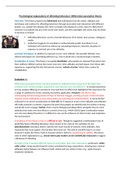Psychological explanations of offending behaviour: Differential association theory
Overview: This theory proposes by Sutherland that individuals learn the values, attitudes and
techniques and motives for offending behaviour through association and interaction with different
people, e.g., people who display anti-crime vs people who display pro crime. Says it is likely that if
someone is socialised into pro crime norms and values, and this outweighs anti-crime, they are likely
to become a criminal.
Offending behaviour can be a learned behaviour from family, peer groups, colleagues,
media
Sutherland suggests it is possible to mathematically predict how likely it is an
individual will commit an offence by calculating frequency, intensity, duration of
exposure to anti and pro crime attitudes.
Learning Techniques: In addition to exposure to pro crime attitude, the possible offender may
witness techniques for committing offences e.g., how to break into a house through a window.
Socialisation in prison: This theory can explain Recidivism, why people are released from prison but
then reoffend. Whilst in prison they learn more pro crime attitudes and techniques from those with
experience, supporting the idea that prisons may be ‘schools of crime’ rather than a place for
rehabilitation.
Evaluation +/-
Differential association theory has been praised for shifting the focus away from the belief that
criminals were ‘wicked’ people, proposed in early theories such as Lombroso’s. It created awareness
on how peoples differing circumstances may lead them to offend and highlighted the importance for
a range of solutions to crimes, showing its positive application. However, this theory risks
stereotyping towards backgrounds of those in financial struggle, creating an issue of discrimination
towards certain individuals in areas when police are searching for criminal activity. It can be further
criticised for its lack of consideration for free will, for if exposure to pro-crime attitudes and attitudes
will make someone a criminal, it ignores the point that people can identify that this activity is wrong
and decide not to engage. Further, there may be biological predispositions alongside the pro crime
attitudes that make one more likely to commit crime (e.g., MA0A+CDH13 gene combination makes
one 13x more likely) Therefore, it is difficult to rule out the influence of other factors and emphasise
the environment.
A weakness of this theory is that it is difficult to test. Though he suggested a mathematical way of
predicting future offending behaviour, there seems to be a lack of, the variables are not
operationalised meaning it doesn’t specify how much exactly of anti/pro crime attitudes, how
frequently they must appear, the duration they must last. This lack of scientific basis is an issue
because it makes the theory hard to measure what it claims to, questioning its validity. This shows
clear in other explanations e.g., neural where grey matter can be scientifically measured to suggest
a likeliness of offending.
Strength is that it explains different types of crime better than other approaches particularly ‘white
collar crime’, being usually financial crimes committed by large corporations, showing how criminal
attitudes and techniques can influence both violent and non-violent crimes. E.g., apple Foxconn
employee standards.





